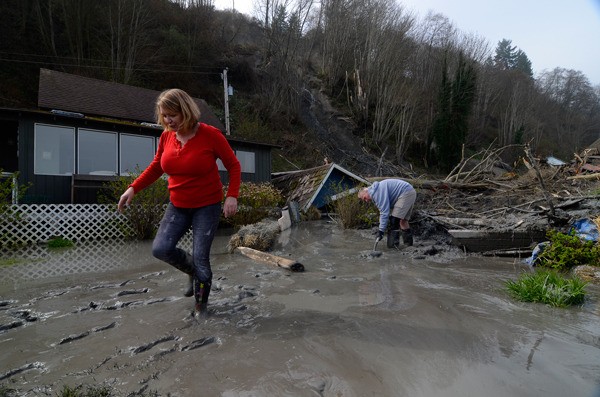An ongoing landslide in Old Clinton has claimed its fifth beach cabin.
Island County officials Monday yellow tagged the home of Judi Sladky, which is located next door to another two-story house that was destroyed in a slide late Friday night. Although Sladky’s place is still standing, the potential for additional bluff movement makes it simply too dangerous for human occupation, according to Bill Oakes, director of Island County Public Works
“It’s just not safe,” he said. “Not right now, it [the bluff] is too unstable.”
A yellow tag allows entry to retrieve personal belongings only. Red tags restrict any entrance whatsoever due to safety concerns.
Oakes also issued a warning to the general public, saying the slide area should be considered extremely dangerous and avoided.
“People should just stay away from this thing,” he said. “It’s not stable, it’s not safe.”
The cabins are located on Campers Row Walk, a walk-in shoreline community between Hastings and South Brighton Beach roads. Friday’s slide was the third major event in a 100-yard area in the past three months. Collectively, they have either destroyed or severely damaged four shoreline houses.
All were largely summer retreats, but Sladky has called her cabin home for the past 25 years and she’s been fighting to keep it since the slide in February. Armed with shovels and rubber boots, Sladky, family members and friends were out clearing mud and debris Friday afternoon just hours before the big slide later that night. They were working in and around the slide path, she said.
“We were just a few hours from death,” said Sladky, of the close call.
A large portion of the bluff came down around 10 p.m., destroying her neighbor’s house, a two-story blue cabin owned by the Rogers family, she said. Roaring mud wiped out the first floor and the roof was shish-kebabed by a large tree.
On Monday Sladky was hoping to get the county’s OK to bring in an excavator to clear some of the largest debris from the side of her home and drain flooding. There didn’t appear to be great amounts of water coming down the slide chute, but the sound of running water was enough to spark questions from several onlookers.
According to Oakes, it’s believed to be groundwater that up until the recent slide had been saturating the bluff. It’s now running more freely and collecting at the bottom of the hill. County officials did check with the Clinton Water District, however, to see if water levels were falling, which might signify a leak.
“This particular event is groundwater driven,” Oakes said. “There’s no surface water.”
Terry Swanson, a Whidbey geologist and principal lecturer at the University of Washington, agreed that the Brighton Beach slides are likely the result of natural processes at work. A large recharge area is located behind the bluff and aerial photos from the 1970s and the 2000s reveal numerous landslide scarps and debris chutes.
Development can play a role in landslides, but most on Whidbey result from a combination of loose soils and heavy rainfall, he said.
“These are saturation slides,” Swanson said.
They happen all the time, though most people only hear about the few that make the news because they destroy homes or cover roads. For example, a large slide happened in Glendale recently that Swanson said he learned about by accident while walking his dog.
He noted that the past four years have been exceptionally wet, which may explain a seeming increase in the number of slides around Puget Sound. Precipitation likely played a role in famous events, such as those in Ledgewood on Central Whidbey and Oso in Snohomish County, but these were “deep-seated” and complex slides, much different than what’s happening to bluffs such as those on Whidbey. They will take years of study to really understand, he said.
“That’s clearly a situation where you need to look at larger-scale processes than whether someone left their garden hose on,” Swanson said.
At Brighton Beach, it’s very possible that more slides will occur, he said. The question is where and when.
According to Oakes, Old Clinton has been mapped for decades, since the 1970s, as an unstable area and people who live there do so at their own risk.
“All of those homes have the potential of an event like this,” he said.
The county has mailed letters to homeowners warning them of the danger.
The status of Sladky’s home may not be permanent. The bluff’s stability will be reexamined by county officials in June. Also, she can hire her own experts beforehand and their findings will be considered, Oakes said.



